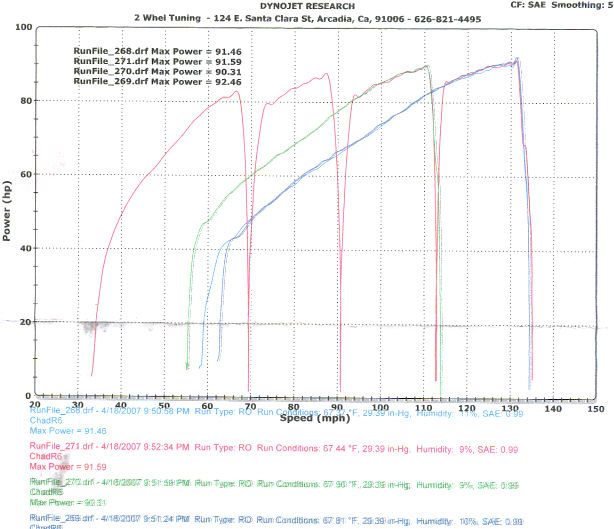| Author |
Message |
    
Shaiss
| | Posted on Friday, April 20, 2007 - 10:42 am: | 





|
I got my bike Dyno'd at the last bike night and heres the result chart.
Can anyone tell me my tourque? Stupid people at the dyno didnt know. Something in the chart doesnt seem right. What you guys think?
I tried to answer the below my best, sorry, I'm a mechanical moron!
Year 2005
Model XB12R
Displ. 1203
Compression Ratio ???Stock???
Intake/Filter K/N w/ American Sport Bike Open Airbox Kit
Carb/EFI Model ???dont know???
Pilot Jet ???doesnt this only apply to carb'd bikes, mines FI???
Main Jet ???doesnt this only apply to carb'd bikes, mines FI???
EFI Augmentation Module remapped by AL @ American Sport Bike
Intake Manifold ???huh???
Heads/Porting ???stock??
Cylinders ???v-twin only has 2 right???
Pistons ???ah, 2???
Header stock
Muffler Jardin RT-1
Cams stock
Lifters stock
Pushrods stock
Rocker Arms (Roller Tipped?) ????
Ignition/ECM Module/Curve huh???
Static Timing (degrees from stock spec) what???
Gear (usually 4th or 5th) I think 4th
Chain or Belt Final Drive Belt
Engine Oil Brand/Grade 10/40 Motul
Tranny Lube Brand/Grade motul harley XL grade
Fuel (Type/Octane) 91
Turbo/Boost I wish!!!
Nitrous/Flow Rate I wish again!!!
Dynomometer Model/Mode not sure
Correction Method (SAE/STD/None) SAE?
Larger View at:
http://i134.photobucket.com/albums/q118/shaiss/dynorun418.jpg
(Message edited by shaiss on April 20, 2007) |
    
Shaiss
| | Posted on Friday, April 20, 2007 - 10:45 am: | 





|

Larger View at:
http://i134.photobucket.com/albums/q118/shaiss/dynorun418.jpg |
    
Blake
| | Posted on Friday, April 20, 2007 - 05:49 pm: | 





|
Shais,
Using your 5th gear run, the blue plot above, you can calculate torque if you can assume that at 132 MPH the engine was hitting the rev limit (6,800 RPM).
The old HP=T/5252 formula reduces to the following in your case in terms of 5th gear MPH in lieu of RPM:
First we note that the RPM in 5th gear can be found as...
5th Gear RPM = 6800/132*MPH = 51.5*MPH
T=HP*5252/RPM
For your specific case of a 5th gear run then...
T=HP*5252/(51.5*MPH) (for 5th gear run only)
T=HP*102/MPH
Again, this only applies specifically for your 5th gear pull above.
Also note that for your 5th gear pull, the magnitude of torque in FT-LBs at 102 mph will be equal to the reported HP.
Looks like at 100 MPH (~5,670 RPM) the torque is around 77 FT-LBs. Again for the 5th gear run.  |
    
Blake
| | Posted on Friday, April 20, 2007 - 05:52 pm: | 





|
Oh, and THANKS for taking time to provide all the applicable info about your bike and its configuration. The cylinders and pistons are for designating whether OEM/stock or aftermarket parts.  |
    
Shaiss
| | Posted on Friday, April 20, 2007 - 06:11 pm: | 





|
Thanks Blake, I tried.
Thanks for taking the time to calculate that for me Blake. Do you think these are good figures or does something seem off?
I have to give thanks to Al at American Sport Bike for remapping my stock ecu for a near perfect power curve.
Ah, forgot to mention to that the bikes been de-smogged.
However, I have to say that I'm really disappointed. After all the work I've done it looks like the bike actually has less torque and HP then stock. How is this possible?
according to Buell.com stock is
103 HP @ 6800 RPM
84 ft. lbs. @ 6000 RPM
Are they measuring it at the engine as opposed to the wheel? |
    
Blake
| | Posted on Saturday, April 21, 2007 - 07:10 am: | 





|
You are entirely welcome. I'm happy to put some math to good real world use. 
You are correct about the performance values reported by Buell, they are at the crankshaft using an engine dynamometer. They are also measured using a brake dynamometer rather than an inertial dynamometer.
Drivetrain inefficiencies (friction and viscous fluid effects) and inertias (it takes power to spin up the rear wheel/tire and all the other rotating/spinning bits in the drivetrain) typically consume about 10% to 15% of the total peak HP produced at the crankshaft as power is transferred through the drivetrain to a chassis dynamometer's drum via the rear tire.
In addition to avoiding all drivetrain power losses, an brake style engine dynamometer also avoids power losses due to inertial effects within the engine itself; it takes a significant amount of power to accelerate the big flywheel and generator rotor on the Buell engines. An engine (rather than chassis) brake (rather than inertial) dyno, which can hold the engine at a constant speed, therefore avoids inertial engine power losses as well as all drivetrain power losses.
Your results look excellent to me.
However, judging from your profile pic, the bike seems to be acting up a bit. Might want to have that checked out. The renowned Buell handling goes out the window with the front wheel off the ground like that.  |
    
Firemanjim
| | Posted on Sunday, May 06, 2007 - 07:18 pm: | 





|
Was the humidity really 9-10% ??? |
    
Shaiss
| | Posted on Sunday, May 06, 2007 - 10:53 pm: | 





|
well, not sure if 10% is really wet or really dry.
But the Dyno was done at the Bike Night at Corona, CA.
For those not familiar this takes place in the Orange County mountains where teh weather is usually about 40F. |
    
Diablobrian
| | Posted on Sunday, May 06, 2007 - 11:11 pm: | 





|
10% humidity is REALLY dry. |
|
 »
Dyno Run 4/18, is this good?
»
Dyno Run 4/18, is this good?
 »
Dyno Run 4/18, is this good?
»
Dyno Run 4/18, is this good?